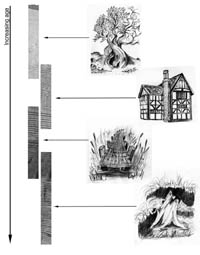What is dendrochronology
Dendrochronology or tree-ring dating has been available as a recognized scientific technique since the early 1900s. Simply stated, trees in temperate zones (and some in tropical zones) grow one visible ring per calendrical year.
For the entire period of a tree's life, a year-by-year record or ring pattern is formed that in some way reflects the climatic and environmental conditions in which the tree grew. These patterns can be compared and matched ring for ring with trees growing in the same geographical zone and under similar climatic conditions.
Following these tree-ring patterns, the sum of which we refer to as chronologies, from living trees back through time, we can thus compare wood from old or ancient structures to our known chronologies, match the ring patterns (a technique we call cross-dating), and determine precisely the age of the wood used by the ancient builder.
This technique was pioneered by A. E. Douglass working in the American Southwest, and has since been applied in many areas of the world.
Please see our procedures page for details of the basic dendrochronology procedures used in the Cornell Tree-Ring Laboratory.

Trees of successively older ages are cross-dated to produce a chronology.